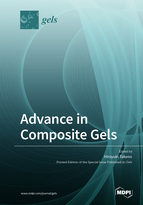Advance in Composite Gels
A special issue of Gels (ISSN 2310-2861).
Deadline for manuscript submissions: closed (30 May 2022) | Viewed by 79980
Special Issue Editor
2. Gunma University Center for Food Science and Wellness, Gunma 371-8510, Japan
Interests: composite gels; small-angle scattering analysis; food gels; gel actuator
Special Issues, Collections and Topics in MDPI journals
Special Issue Information
Dear Colleagues,
Generally, polymer gels prepared by a conventional method are mechanically weak and brittle. To overcome their drawbacks, various composite gels have been developed. For example, the incorporation of nanofillers such as inorganic nanoparticles or nanofibers into polymer gels allows enhancement of mechanical performance. Advanced composite gels exhibit unique properties, such as stimuli-responsive properties, self-healing, excellent electrochemical properties, as well as excellent mechanical properties. Composite gels with unique functionalities offer potential applications in various fields, such as electrochemistry, cosmetics, biomedical tissue engineering, sensors, drug delivery systems, and soft actuators. However, the fabrication of composite gels with desirable functionalities remains a challenging problem.
This Special Issue focuses on recent research and advances in composite gels, such as polymer–inorganic composite gels, polymer–nanofiber composite gels, bio-based composite gels, and composite ion gels. Additionally, we welcome contributions regarding the structural analysis of composite gels, modeling, and simulation.
Prof. Dr. Hiroyuki Takeno
Guest Editor
Manuscript Submission Information
Manuscripts should be submitted online at www.mdpi.com by registering and logging in to this website. Once you are registered, click here to go to the submission form. Manuscripts can be submitted until the deadline. All submissions that pass pre-check are peer-reviewed. Accepted papers will be published continuously in the journal (as soon as accepted) and will be listed together on the special issue website. Research articles, review articles as well as short communications are invited. For planned papers, a title and short abstract (about 100 words) can be sent to the Editorial Office for announcement on this website.
Submitted manuscripts should not have been published previously, nor be under consideration for publication elsewhere (except conference proceedings papers). All manuscripts are thoroughly refereed through a single-blind peer-review process. A guide for authors and other relevant information for submission of manuscripts is available on the Instructions for Authors page. Gels is an international peer-reviewed open access monthly journal published by MDPI.
Please visit the Instructions for Authors page before submitting a manuscript. The Article Processing Charge (APC) for publication in this open access journal is 2600 CHF (Swiss Francs). Submitted papers should be well formatted and use good English. Authors may use MDPI's English editing service prior to publication or during author revisions.
Keywords
- nanocomposite hydrogels
- bio-based composite hydrogels
- organic–inorganic composite hydrogels
Related Special Issue
- Advance in Composite Gels (2nd Edition) in Gels (10 articles)







